
THE CRADLE OF CIVILIZATIONS EXTENDING FROM THE PAST TO THE PRESENT; SYRIA
By Didem Can, December 2024
Syria has been home to many civilizations since agriculture and animal husbandry began to be seen for the first time. The civil war that has been going on in the country since 2011 has evolved to a different stage with President Bashar al-Assad fleeing the country on December 8, 2024
If we look at the milestones in the country as astrological indicators, we have to go back to the important major breaking points for Syria. Since the charts used do not have dates and times (belonging to ancient periods), this article is considered in terms of the cycles of slow-moving planets. It will be more useful to approach the charts with this awareness.
Ottoman Period
Syria, part of the Ottoman territory between 1516 and 1918, was reorganized as a large province by the Ottomans.
Since the country has been a part of the Ottoman Empire for 400 years, the planetary combination of the year 1516 will give us a clue about the course of the country.
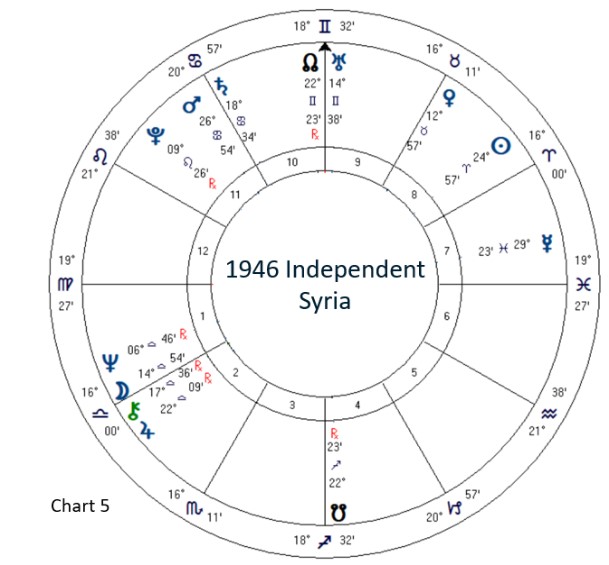 In the Ottoman period chart, we see that both slow-moving planets (Pluto and Uranus) changed signs consecutively. With the entry of Pluto into Capricorn, the 400-year Ottoman reign began in the country, which Uranus had already recently entered Taurus. So the sky was dominated by an energy that changed the story.
In the Ottoman period chart, we see that both slow-moving planets (Pluto and Uranus) changed signs consecutively. With the entry of Pluto into Capricorn, the 400-year Ottoman reign began in the country, which Uranus had already recently entered Taurus. So the sky was dominated by an energy that changed the story.
We can say that the trine aspect of these two planets has loaded the collective with new ideas and energy that fuels radical change. In history, the cycles of this duo are coincide with the periods when new places were conquered and expanding territories were restructured.
The Ottomans reorganized Syria as a large province. The state was divided into several districts or sanjaks. Every religious minority in Syrian society - Shiite Muslim, Greek Orthodox, Maronite, Armenian, and Jewish - formed a nation. The religious leaders of each community administered all personal status laws and also performed certain civic functions.
There is no doubt that the Uranus-Pluto trine, which takes place in the earth signs, leads to a strong organizational process. As a result of this, we see a unified country structure consisting of religious groups by dividing into provinces.
Syria under French Mandate
By the Sykes-Picot agreement signed between Great Britain and France in 1916, Decertified by Russia and Italy, Syria became a League of Nations mandate under French control in 1920.
In the 1920 Chart, Pluto changes its zodiac sign and ingress to Cancer. Just like in the Ottoman chart, it is in a trine aspect with Uranus. (Chart 2) In other words, both charts have the same configuration.
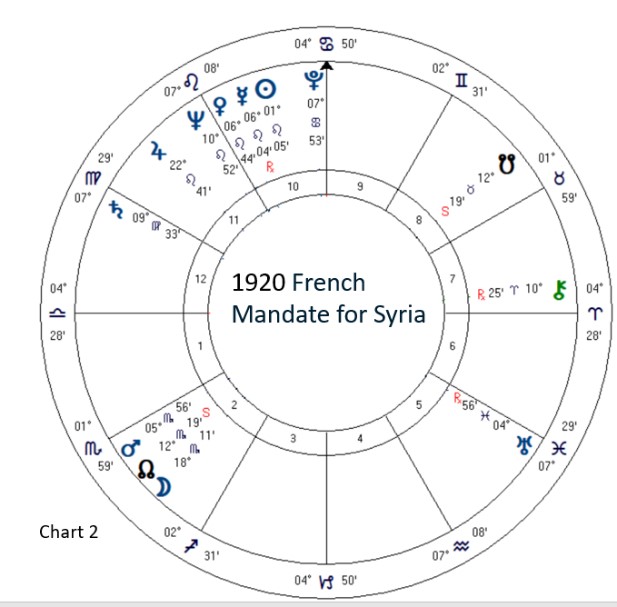 France has managed the Syrian territory by dividing it into six parts according to the sectarian diversity in the region. Although the reason for this division was to prevent the Arabs from forming a national union and resisting the French mandate in the future, almost all religious groups opposed the French and resisted living under their rule.
France has managed the Syrian territory by dividing it into six parts according to the sectarian diversity in the region. Although the reason for this division was to prevent the Arabs from forming a national union and resisting the French mandate in the future, almost all religious groups opposed the French and resisted living under their rule.
The Pluto-Uranus trine, which appears in the chart of both the Ottoman Empire and the French Mandate, manifests itself in the form of Syria being divided into parts (Uranus) and governed (Pluto). Since the combination of these two also symbolizes a political approach aimed at destroying deep-rooted structures and attitudes, the sectarian division process that the country has entered into has brought radical developments with it.
We can say that the Saturn-Uranus opposition and Jupiter-Neptune conjunction in the chart of the Mandate of France also contribute to this structure in a significant way. These combinations also constitute other indicators of the restructuring period with great ideals in symbolism.
In particular, we can say that the Pluto Cancer period caused the love of country to turn into nationalist tribalism during the First World War and after. This period is the period when borders change rapidly and radically, families are torn apart due to wars, and the need for housing comes to the fore significantly. As humanity, we observed the most violent transformation of Crab symbolism in the collective during the First World War.
The Saturn-Uranus opposition wants to turn innovation into action rather than addressing it at the level of ideas. Otherwise, it creates constant tension and unrest. The transition of Syria to the French mandate and its sectarian division also formed the basis for France to face resistance in almost every region separately.
Saturn-Uranus on the Pisces-Virgo axis, we can say that rebellion against authority and the need for freedom are an important factor that works in the background of the formation of events leading to a counter-revolutionary uprising in the country.
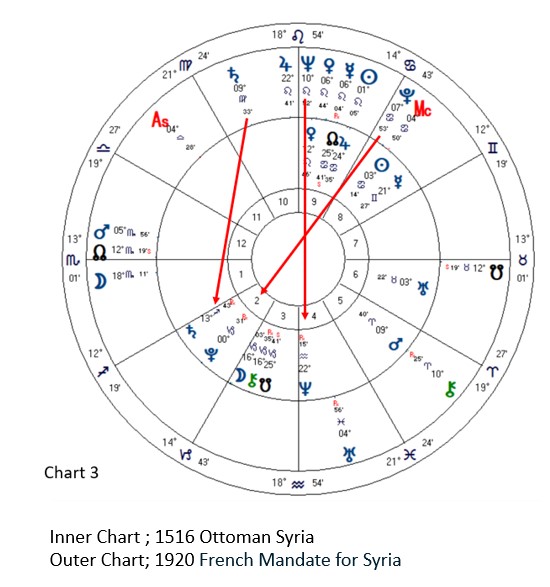 When we compare the 1920 chart with the Ottoman Empire period chart, the most striking effect is the Pluto-Pluto opposition, the Neptune-Neptune opposition, and the accompanying Saturn-Saturn square. (Chart 3)
When we compare the 1920 chart with the Ottoman Empire period chart, the most striking effect is the Pluto-Pluto opposition, the Neptune-Neptune opposition, and the accompanying Saturn-Saturn square. (Chart 3)
The cycle of two collective (Pluto-Neptune) planets is 498 years. This half-century cycle represents the blending of the driving force (deep motivation) in our nature and dreams/ideals that transcend reality. The transition of Syria from the Ottoman Empire, which milestone, to the French mandate, takes place with the simultaneous cycle of these two collective planets.
In fact, during this period, humanity collectively rewrote and redefined its reality. the 1920s represent the period after the First World War, when there was a lot of loss.
Just as the First World War could not solve the problems between the countries, as a result of treaties containing heavy sanctions, ideologies such as extreme nationalism, newly formed fascism, and national socialism developed after the war paved the way for World War II. Empires have been destroyed, and many new states have been established instead. I think the 1920 French mandate chart explains the end of the Ottoman Empire's 400-year rule over Syria with the simultaneous opposition of Pluto and Neptune.
Independent Syria
Syria gained independence on April 17, 1946, but the country's politics were marked by uprisings until the late 1960s
Although France maintained its military control and economic dominance, it accepted Syria's independence in principle in September 1936. If we look at this period, we see that Pluto is about to leave the sign of Cancer. (Chart 4)
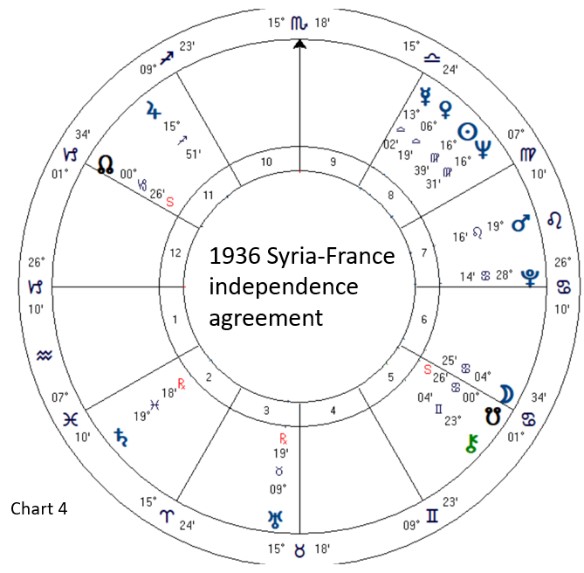 The mandate of France, which began with the ingress of Pluto into the sign of Cancer, is nearing its end when the planet leaves the Cancer.
The mandate of France, which began with the ingress of Pluto into the sign of Cancer, is nearing its end when the planet leaves the Cancer.
Full independence took place in 1946. Again, a new era begins with the transition of Pluto to a new sign (Leo).
In the Independence chart, we observe the sextile aspect of Pluto and Uranus (Chart 5)
When we look at Syria's previous periods such as the Roman Empire in 273, 395 Eastern Rome, 1181 Ayyubid dynasty, 1400 Timurlenk periods, we see the same sky combinations; Pluto is changing its zodiac sign and is located at a significant angle with Uranus besides Saturn's aspects. This situation shows us that Syria is sensitive to the cycles of the planets Pluto and Uranus.
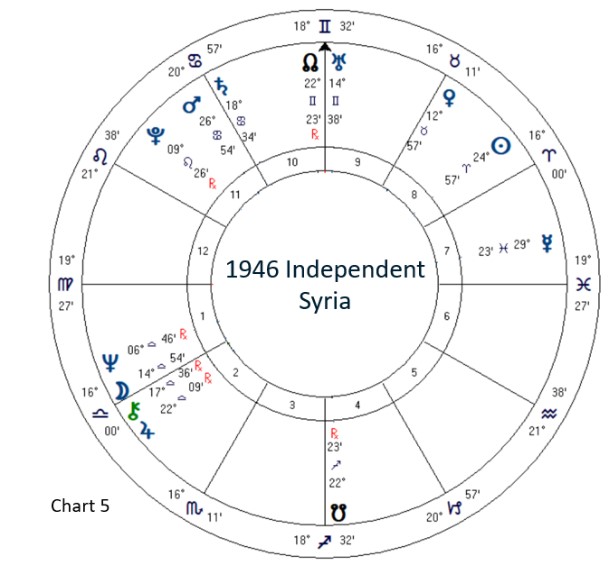 with the fall of France in 1940 (during the Second World War), its control over Syria began to decrease, and as a result of the continuing pressure of Syrian nationalists with the support of the British, the country achieved independence in 1946.
with the fall of France in 1940 (during the Second World War), its control over Syria began to decrease, and as a result of the continuing pressure of Syrian nationalists with the support of the British, the country achieved independence in 1946.
On the other hand, the Jupiter-Saturn square is the prominent aspect of the 1946 chart. (Chart 5)
We see Jupiter-Saturn conjunction in the year 1920 (towards the end of the year), that is, during the French mandate period. The Syrian border was recognized internationally in 1920 and has not changed until today.
When we compare the 1946 Independence chart with both the Ottoman Syria and the French Mandate chart, we again see Pluto and Uranus are actively being triggered and triggering. (Chart 6)
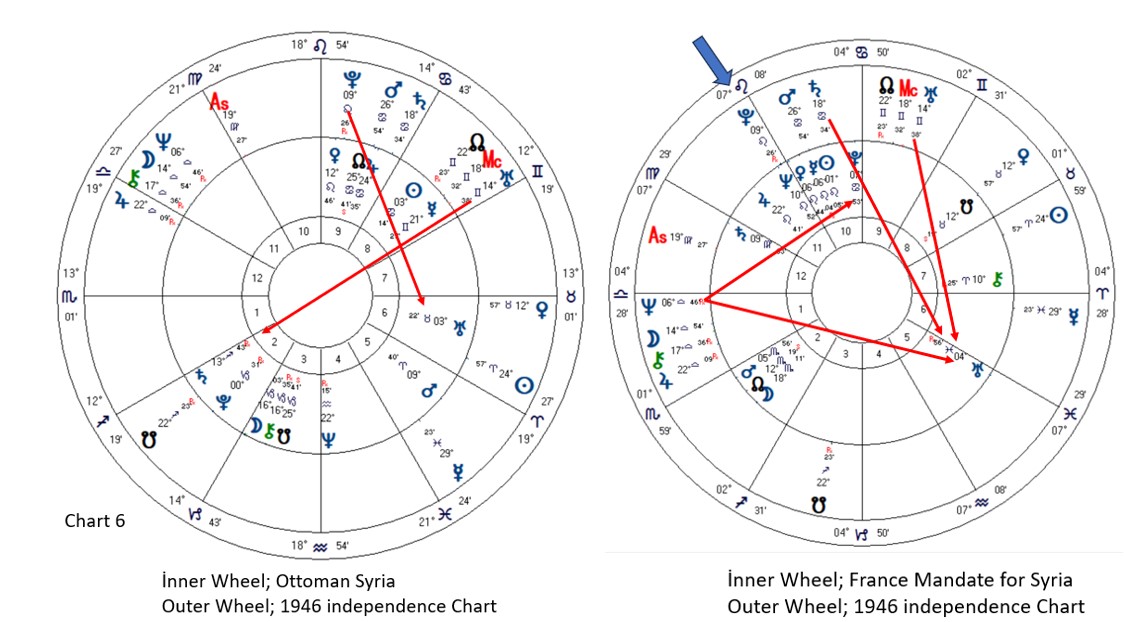
The changes in countries evolving over the course of history do not eliminate their previous charts. The charts that we think have lost their priority are still active and continue to work dynamically in the background.
Planetary cycles stand out more in mundane astrology because the fact that things change collectively is just part of the fact that countries and cultures change along with it.
Ba'athist Syria
The power was seized by members of the Arab Socialist Baath Party in a coup on March 8, 1963. The Baath Party ruled Syria as a totalitarian state, and they took control of the country's politics, education, culture, religion, and controlled civil society through the powerful secret police. (Chart 7)
.jpg) In the 1963 chart, we see the Saturn-Neptune square accompanying the Pluto-Uranus conjunction.
In the 1963 chart, we see the Saturn-Neptune square accompanying the Pluto-Uranus conjunction.
The Pluto-Uranus combination helps to break the patterns that we have always been used to. Therefore, we observe the strong effects of this duo throughout history. It would not be wrong to say that the conjunction of Uranus (destructive action) and Pluto (overwhelming force) served the collective as a springboard or threshold. As slow-moving planets, it naturally takes time for us to see the fruits of the seeds thrown by the conjunction.
This month we witnessed the collapse of a 61-year-old regime with Bashar al-Assad fleeing his country on December 8, 2024. In fact, 61 years corresponds to the half-time of the 127-year Uranus-Pluto cycle
While the conjunction of the Pluto-Uranus brought a new regime to the country through a coup, we observed that chaos occurred in the country along with civil war when the cycle progressed to a square aspect in 2011. At the point where we have arrived today, Syria is about to be reborn from its ashes. The existence of states or groups that still claim rights over the country's territory preserves its effectiveness. in 2026, when Uranus-Pluto makes the trine aspect, we will most likely face a divided Syria again, just like in the Ottoman and French periods charts